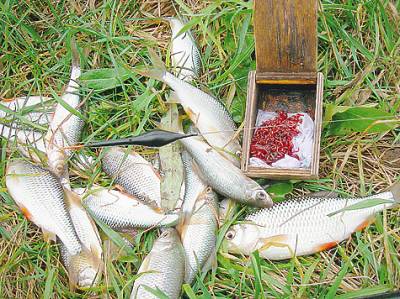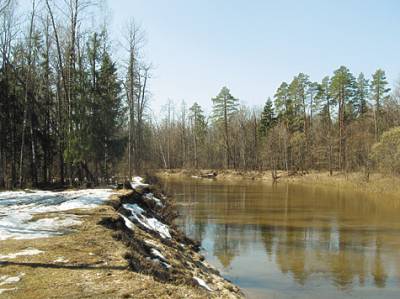
Early summer fishing in lakes, ponds and reservoirs without current different fishing conditions, and fish behavior. Underwater vegetation just starting to grow, and insects and their larvae have not reached numbers sufficient to feed the hungry fish.
At the end of spring fish, not finding food in the bottom layer, preys on flying butterflies, mosquitoes and flies. At the top, more heated layers of water concentrated in small crustaceans. Behind them rise to the surface of roach, bream, perch and even bream. In this respect, fishing becomes Dobychina in half-waters or even on the surface. I like catching roach in half-waters because of its technicality and efficiency, and also because there is a high probability to catch a big fish.
The most convenient and promising those places where the depth starts directly from the shore. For example, if at the distance of ten meters water depth of three meters already, the roach are required to have. With enough patience it will be possible to take the bait on an even shorter distance, but is closer to 5-7 meters from fisherman roach will bite gently and not too often. Seen when a roach climbs in the middle and upper layers of the water, it still adheres to the edge or the bend of the bottom. Thus, fish during the day, changing horizons, without making migrations. If selected for the fishing part of the reservoir is shallow, with a gentle lowering of the bottom from the shore, you should choose the point of fishing in which the depth of at least half a meter.
Fishing for roach in half-waters is one of those cases where a slight centrifugal rod competes very successfully with a plug. The rod should be maximally easy and poilite to accurately throw the light a snap. Enough to have a “six” and “seven”, but I always take “eight”, “nine”, in case if the water level falls and fish departs from coast. Suggest to have two fishing rods with equipment of different weight. On one rod, for example, the snap-in 0.4-0.5 g, and the other is 0.7 – 1.0 g
Snap I mount on the line of 0.06-0.09 mm, with a hook no larger than No. 16, which depends only on the size of the lure. Along the way, can bite a decent carp, but as practice shows, modern fishing line 0.07 mm on a good rod successfully “cope” with 600-800 carp in the Distribution of shipping highly-simplified, because the snap-in is very easy, often you have to change the descent and do a lot of perezapisi. Leash length is selected depending on the weight of the lure, speed of drift snap under the action of a water wave, the depth of the descent and activity of the roach.
Bait for roaches, regardless of the time of year plays a relatively more important role than for most other cyprinid fish. One of the reasons is that the roach is omnivorous, and its competitor can serve unless Rudd. Roach eats everything: algae, fry, and active. But it remains a very cautious fish, and most importantly – legible. The period of mass flight of moths-mayfly, mosquito flight of the moth, the spawning of a particular fish, severe and prolonged rains increase the water level in the reservoir, which washed away in the water a lot of worms, affect the flavours of the roach. In addition, roach, and bleak, adequately responds to the way the bait goes under her nose, it is one of those fish for which a “serving” is of great importance. If the bait will be to pour a stream or lie on the bottom in the form of dense balls, its positive effect will be reduced to a minimum. You want the lump of bait was falling apart after hitting the water surface. If you have cooked too viscous composition, the bait can be reduced to a semi-liquid state water. Would be awkward to throw. If the bait was very fluid, I can advise to add dry ground cake, which instantly take away excess water.
Selection consistency, frequency of feeding and size it doses of bait – values are correlated, but variables. There are two General rules. The first is that the more active the roach, the more “liquid” could be the bait, that is “pillar”, as when fishing bleak. You can and often need to lure in small portions. The total number of bait can be 5-7 kg per fishing.
The second rule refers to the case when the roach is inactive. Sometimes it only takes two or three handfuls for all fishing. Skarmlivanii is carried out immediately, and while catching complementary feeding is microscopic doses, literally the size of a cherry. And the bulk of such bait is bloodworm or maggots.
So before you start to fish, I cook the mixture just enough to have enough fishing in the first hour. This is enough for a pound of the mixture.
If the activity of the roach manages to match the pace of fishing, the fishing technique is very simple. The most effective should recognize the transaction for the fall and artificial wiring.
Wiring for fall is that you first make a descent on the tool equal to the depth in the point of fishing. After casting the rod is fixed, the line is taut and the bait that slowly sinks through the arc. The slower falling bait, the higher the probability of a bite. During the fall snap in the water column, the float captures the depth achieved by gruselle. It is better to choose floats of elongated shape. Once the float is in the water working position, that is to dive under the antenna, it is necessary to make a pause, during which will drop the hook with bait. It was in these few seconds has the highest number of bites. If after two or three casts of the bite happens, I reduce the descent about twenty centimeters and repeat all over again. After the horizon the bite is detected, the intensive fishing.
While calming the bite again, we have to change the descent. After some time, when at the bottom builds up the bait, it makes sense to increase the descent to the bottom and let the snap-in free swim under the influence of surface currents. If the pond is calm, then you should make an artificial transaction. To do this, slowly and evenly to snap using fishing rods to the side. Wiring speed easily controlled by the degree of “vylezanija” body float out of the water. If the pond is at least how palpable the excitement of the water from the action of the wind, it is better to apply the posting to oderico. After the snap-in straight after falling in the water and a hook with bait will be near the bottom, you give a snap to swim twenty to thirty centimeters in wave and stop her movement with the rod. After a few seconds ottoriki, once again you let a snap sail on the wave and again I stop. A light bait on a long and thin leash enjoys bottom over and lifted from the bottom. When you release the snap, again the lure slowly falls to the bottom.
If no bites for a long time, try to do the following. Increase or decrease the length of the leash. Place the snap with another weight. Change the bait on the hook, this will replace a single larva of the moth in three or Vice versa. Try to make several transactions below or above the point of fishing. Replace the hook on the smaller ones. Change the slope. In any case, you need to remember the General rule that the more careful the bite, the more often you need to change the bait on the hook and more accurate to apply it to the point of bites. This applies particularly to the bloodworms.
As bait, except for the bloodworms I use maggots. From the good maggots roach spring refuses extremely rare, moreover it can peck and perch, and gudgeon, and bream with bream. To further slow down the fall of the lure in the water, it makes sense to combine on the hook for maggot and caster, which is lighter than water. If bloodworms in the bait not, you should try to lure a piece of bread or dough.
There are days when the roach are biting very carefully tries the bait, but takes rarely. In such cases, I leave the gear and go in search of caddis. If the caddis worm does not help, then fish at the selected location no.








